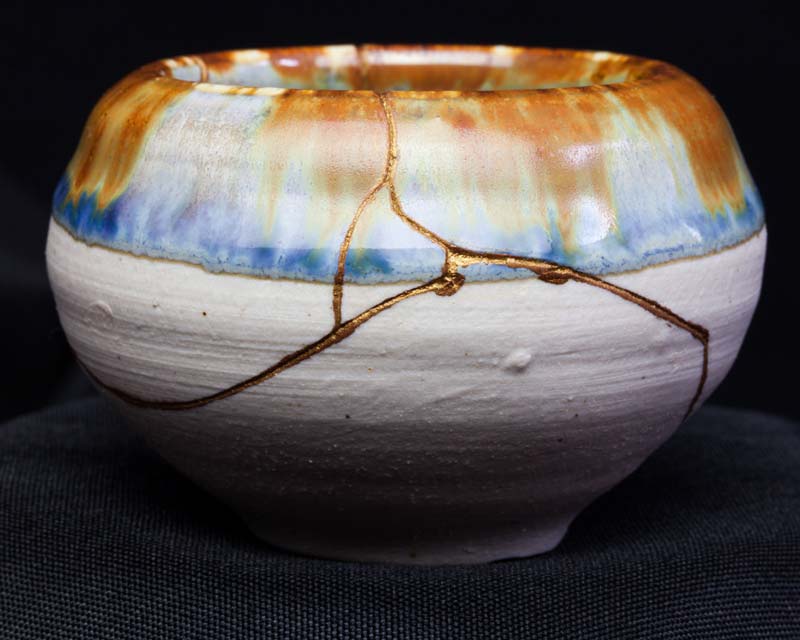 Kintsugi is the ancient Japanese art of repairing fractured pottery by using a form of resin mixed with powdered gold.
Kintsugi is the ancient Japanese art of repairing fractured pottery by using a form of resin mixed with powdered gold.
Social media and societal norms often suggest, in not so subtle ways, that perfection is what you must outwardly project and inwardly achieve. The message is clear: Every Instagram story and Facebook post must portray an image of pure awesomeness.
If you do not have it all together and cannot properly frame it up in that selfie or snap that picture of your gourmet meal and share a moment from your amazing vacation, you are somehow less-than. Sadly, these pictures of perfection are not only "not real," but they also prevent us from being and becoming our most powerful, authentic and impactful selves.
Hiding behind the masks of perfection in our schools and houses of worship, at work or with friends may seem to be what we are supposed to do, but it is wreaking havoc on our psychological well-being and sinking our souls.
Part of the answer to the overwhelming anxiety in teens, and adults for that matter, is found in giving up the artificial assertion of perfection. Only then can people show courageous vulnerability, celebrate scar tissue and find the beauty and power in brokenness.
Breaking down the facade of perfection and fixing the underlying anxiety start with honest, authentic conversations in our homes and communities. Parents not only must listen and ask questions; they must also model the right kind of behavior. Rather than telling a teenager to "buck up" or "get over it" when they notice stress or anxiety in a child, parents must show empathy and be brave enough to share their own anxieties or stressors. Saying something like, "I can see how you would have anxiety over that situation at school. At work today, I was ready to crawl under my desk rather than face that angry client."
Courageous vulnerability may be one of the most important attributes for parents and their children to develop. Being able to ask for help, clearly state stressors and articulate worries or weaknesses without feeling worthless are key components for having crucial conversations about mental health. Recently, athletes like Olympic swimmer Michael Phelps, BYU football quarterback Tanner Mangum and NBA star Kevin Love — along with his Cleveland Cavaliers coach, Tyronn Lue — have all shown courageous vulnerability by sharing their struggles with anxiety and depression. These celebrities are good models, but we also need parents, teachers, friends and neighbors who are willing to open up and authentically share.
Author Brene Brown wrote, "Vulnerability sounds like truth and feels like courage. Truth and courage aren't always comfortable, but they're never weakness."
Sen. Ben Sasse, a Republican from Nebraska, wrote in his book "The Vanishing American Adult" about how we are often "bubble wrapping" our children in an attempt to protect them from failure, discomfort or pain. The message sent is that failure is fatal and teens should never risk looking bad in front of others. Sasse believes we should do the opposite. He says we should "celebrate scar tissue." Falling off of a bike, failing to make the softball team, losing a class election or being rejected for a job are all opportunities for growth and may contain critical life lessons. Following the adage of seeing failure as fertilizer for future success might be exactly the message our young people need.
During my time in Japan, I became intrigued with the ancient art of kintsugi. Legend has it that it began with shogun Ashikaga Yoshimasa, who broke a treasured teacup. After numerous failed attempts to fix the cup, a team of artisans put it back together using a form of resin mixed with powdered gold. The result was not only the restoration of a prized teacup but the complete transformation of the cup into a piece of art with golden lines where the break occurred.
When a teapot, vase or saucer is damaged, it breaks in unique ways — no two cracks or fractures would ever be the same — meaning the golden scar from the kintsugi process is always distinctive. The word kintsugi literally means "golden repair," but many refer to it as the art of precious scars.
All of us are broken. By acknowledging our flaws and imperfections, we can find the beauty and strength that come from our brokenness. The chips and cracks of life, failure, frustration and anxiety can create golden scars that make us stronger and immensely more valuable.
Getting past the false mask of perfection, learning to be courageously vulnerable, celebrating scar tissue and understanding the infinite value within the brokenness of every human being will help parents and teens better navigate the often debilitating space of anxiety and depression. By confronting some uncomfortable conversations, with each other and within ourselves, we may find that we can actually become stronger in our broken places and have priceless scars of gold to prove it.


 Contact The Editor
Contact The Editor
 Articles By This Author
Articles By This Author